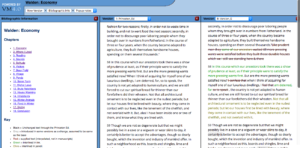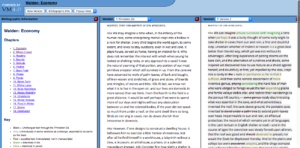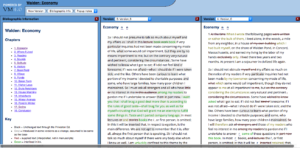Written by Jessica Drechsler, Kennedi Wittenrich, Micayah Ambriz, and Nicole Fyvie
As we started the timeline project, we determined that the purpose was to not only find events that happened during the time Thoreau was at Walden, but to look at events that happened before and after Walden. Some of the events that occurred early in Thoreau’s life, contributed to how he ended up at Walden. For example, in 1821, Thoreau’s uncle and father started up in the pencil-making business. This is an important event, as it helped Thoreau to afford to be able to go to Harvard. Then, without Thoreau meeting Emerson, he wouldn’t have been offered a piece of land on the shore of Walden Pond, which he used during his time at the pond. Also, without Thoreau being able to build a house on the pond, he wouldn’t have written his journals that ended up contributing to his book Walden. The events that were occurring around the world during this affected Thoreau’s life after he left Walden. For example, the Civil War was occurring after the time that Thoreau left Walden. Through this, Thoreau became involved in the abolition and spoke at different events regarding this topic. The purpose of this project was to include different times in Thoreau’s life and events around the world, that contributed to Thoreau’s life overall.
Due to previous experiences with group projects, we decided to equally divide up the work in order to ensure that all members were contributing equally. This is very important when working as a group to ensure that one person isn’t simply doing nothing while everyone else does all the work. When creating the timeline we decided to create three parallel timelines that would detail different events that were important to the creation of Walden. The three timelines were titled “life”, “world”, and “walden” and they detailed different important events pertaining to those categories. Jessica was responsible for the life events of Thoreau that led up to his creation of Walden, Logan went through and added different important historical events during the time period, Nicole focused on Thoreau’s time during Walden, Kennedi focused on life after Walden, and lastly Micayah pulled information from Walden and the Selection of Journals about his time at Walden. By dividing up the work in such a precise manner it allowed us to work more productively and accurately. Instead of constantly asking “what is it I’m supposed to be doing?” we all knew what work was assigned of us and completed it.
As we were working on this project we ran into a few challenges. Some challenges were harder than others but in the end, we were able to figure everything out. One of the challenges we ran into was that the Knight lab timeline website crashed a few times. We didn’t need it to work on the project but it was nice to have so we could see when the website crashed we had to figure out how to work on the project without using the website to see how our work was coming out. We did not find a solution to this problem but the website was restored the next day so we were able to use it in class. A second challenge we ran into was that we wanted to have a picture of the different versions of Walden and we couldn’t find any pictures on it. So what we did was went to the fluid text website and took screenshots of each version we talked about. But you can’t upload an image into the timeline excel sheet, you need an image address. What we did was we uploaded the screenshots into a blog post and posted it on our classes blog website. This gave each image a URL and we were then able to use it in our project. Another challenge we faced was that we wanted to organize this timeline into different sections and we didn’t want to have more than one timeline. What we found was that we could do this by putting a name in the group column all the way on the right of the excel sheet. The three names we used were Life, Book, and World to categorize what each point was represented too. The last challenge we faced was that at one point we couldn’t get the excel URL to work in the timeline website. We had to figure out why it wasn’t working and how to fix it. So we went through the whole excel sheet to see if everything was filled out correctly and there were no blank spaces. What we found was that the Dates column name was accidentally deleted and it won’t work unless that box was filled in. To make it work we just put in the title dates and the URL worked again on the timeline website.
While completing this Timeline Project on Walden, we learned many new things about Thoreau. We learned that he was inspired by Emerson to change his name from David Henry Thoreau to Henry David Thoreau. He went to Harvard, which at the time only cost $179 for both room and board and tuition. Even at such a low cost compared to today, he could barely afford to go. Luckily, his family owned a Pencil Business and they were able to scrape together enough money for him to attend Harvard. He went to jail for not paying the poll tax because it supported slavery and he didn’t agree with that. We learned that he built the house at Walden and later gave lectures based on the different chapters in Walden. Finally, in 1862, 10 years after the first publication of Walden was released and towards the end of his life, we learned that Thoreau changed the title from Walden or Life in the Woods to just Walden.
The main tool that we used in completing this project is TimelineJS. The website has you open a google sheet template in which you input the information and images for the timeline. The layout had you include dates, headline, text, the URL of the image, image credit, and an image caption. Since Timeline JS used a google sheet to store the data, everyone in the group was able to work on it at the same time and it was more accessible than most websites. The website was also free to use and the order in which we found and included information didn’t matter since the website inputs the actual timeline based on the date of the event. Due to the nature of our topic, it was able to accommodate the use of more than one grouping on the timeline itself. In this way, we could group together the information into three separate lines on our timeline; life, book, and world. There were some limitations for this website, however, and one of these was that the website would occasionally crash. Also, if anything was inputted incorrectly or incompletely, the timeline wouldn’t accept it and an error file will appear. Also, only an URL can be used for images in the google sheets. Therefore, any images such as screenshots from websites had to be uploaded onto a separate website in order to put it into the timeline.





